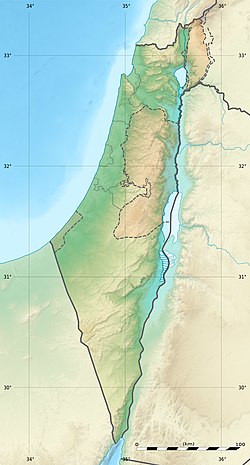Top Qs
Timeline
Chat
Perspective
Chezib of Judah
Canaanite - Israelite town of Judah From Wikipedia, the free encyclopedia
Remove ads
Chezib, also known as Achzib of Judah (Hebrew: אכזיב; כזיב), is a biblical place-name associated with the birth of Judah's son, Shelah (Genesis 38:5), corresponding to the Achzib of the Book of Joshua (15:44), a town located in the low-lying hills of the plain of Judah, known as the Shefela. In I Chronicles 4:22, the town is rendered as Chozeba. The town is now a ruin.
Remove ads
Identification
Summarize
Perspective
Historical geographers are divided as to the location of Chezib in Judea. While some identify the site as Khirbet a-Sheikh Ghazi,[1][2] others say that it is to be recognised in the nearby site of Khirbet ʿĒn el-Kizbe (grid position 149/122 PAL).[3][4][5][6] In both cases, the old namesake is preserved in the name of a nearby spring ʻAin el-Kezbeh (ʿĒn el-Kizbe),[7] a place in the Elah Valley near Moshav Aviezer, directly south of Bayt Nattif. According to IAA archaeologists, Zissu and Gass, the location of Khirbet ʿĒn el-Kizbe near the ancient road and the water source by the same name "strongly support identifying this site with ancient Achzib/Chezib/Chozeba," both, on account of the preservation of the ancient name at the water source, and that at its site was found pottery from Iron Age II and the Persian period (including two Royal lmlk jar handles).[3] According to Zissu, the ancient site stretches over an area of approximately eight dunams (nearly 2 acres).[8]
Formerly, the site had tentatively been identified with Tell el-Beide, a site now known as Tel Lavnin,[9] while others placed its location at one of the unidentified ruins near Khirbet Qila and Khirbet Beit Nesib.[10] Archaeologist Boaz Zissu rejects the notion that the site Chezib of Judah could have been Tel Lavnin, saying that "since Khirbet Tell el-Bēḍā / Tel Lavnīn was clearly occupied during the Byzantine Period, it is questionable whether this site is the same as Eusebius’ ruined Chasbi," since Eusebius puts Chezib as a "deserted place" in his days.[11][12] Like many of the ruins of ancient cities in Israel, the site near Kh. a-Sheikh Ghazi has no very well-defined characteristics, but appears to be spread over a considerable area.
One of the problems of identification is that Achzib is grouped with a list of nine towns in Joshua 15:42–44 which are generally thought to be within relatively close proximity to each other in the low lying hills (Shefelah) south of the Elah Valley. For this reason, some have proposed that Achzib of Judah be sought for somewhere between Keilah and Mareshah.[13]
Remove ads
Etymology
The name Chezib, etymologically, is derived from the word "disappointment," "delusion,"[14] "failing" or "lying." In the Aramaic Targum of Pseudo-Yonathan ben Uzziel on Gen. 38:5, as well as in Genesis Rabba (§85), Chezib is rendered as Paskath, said to be the Aramaic equivalent of Chezib ("failing"). Others say that its name is allegedly derived from Shelah's son, Cozeba, who is mentioned in I Chronicles (4:22).[15]
Remove ads
History
Summarize
Perspective
The Lachish Letters makes mention of a certain "Beit Achzi[b]" in the Shefelah, the lower stratum of the Judean range, believed to be the Chezib of Judah.[16] Eusebius, in his Onomasticon, notes of the place that "there the sons of Judah were born; now a desolate place, shown in the territory of Eleutheropolis near Adullam."[2][17]
In classical Hebrew literature, the town is mentioned as being confederate with Pekah the son of Remaliah, the king of the northern tribes of Israel, for which it incurs the divine wrath of the prophet Micah, who uses a play on words to denounce the towns of Maresha, Achzib, and Adullam.[18] Israelite potters are said to have occupied the site during the pre-exilic, late First Temple period.[19] "Sh[eikh] Ghazy" and "ʾAin el Kezbeh" are both shown in the 1880 map published by Conder & Kitchener's Survey of Western Palestine. Today, the sites have mostly been planted over with pine trees by the Jewish National Fund (Keren Kayemet).
Site's distinguishing features
The site at Khirbet a-Sheikh Ghazi is strewn with the remains of razed buildings, and thick walls that are partially standing and which were constructed of fieldstones. Within the environs of the site is a burial chamber built in the face of a cliff, containing six kokîm (niches) and which, according to C.R. Conder, signifies a Jewish burial place,[20] dating back to a period before the nation became subject to the Western powers of Greece and Rome.[21] The site has revealed archaeological relics dating back to the Iron Age, until as late as the Byzantine period.
Gallery
- Near Khirbet Ghazy (Chezib of Judah), showing entrance to burial cave
- Niches within burial cave near Chezib of Judah (near Khirbet Ghazy)
- Old ruins near Chezib of Judah
- Rock-carved wine vat and press, near the ancient ruin of Chezib of Judah
- Reused stones near ruin of Chezib
- Wheat fields in Elah valley near Chezib
- Reused stones that form a wall at Chezib (Achzib) of Judah
- Primitive wine press carved from rock, near Chezib
- Wall at ruin near En el-Kezbe, near Bayt Nattif
- Wall at ruin near En el-Kezbe
- View from ruin near En el-Kezbe, looking south across the Elah Valley
Remove ads
References
Bibliography
External links
Wikiwand - on
Seamless Wikipedia browsing. On steroids.
Remove ads













